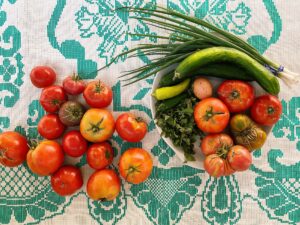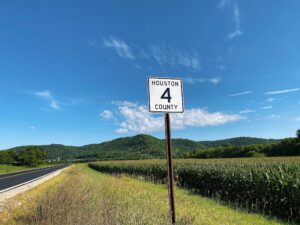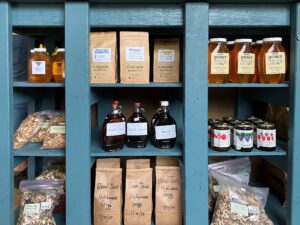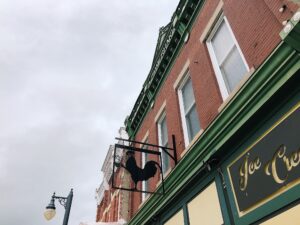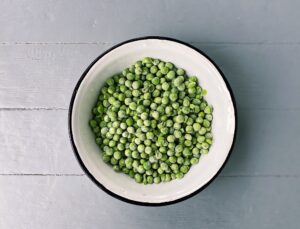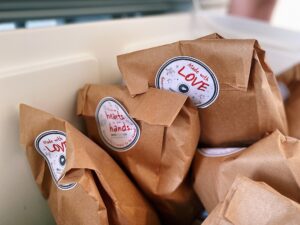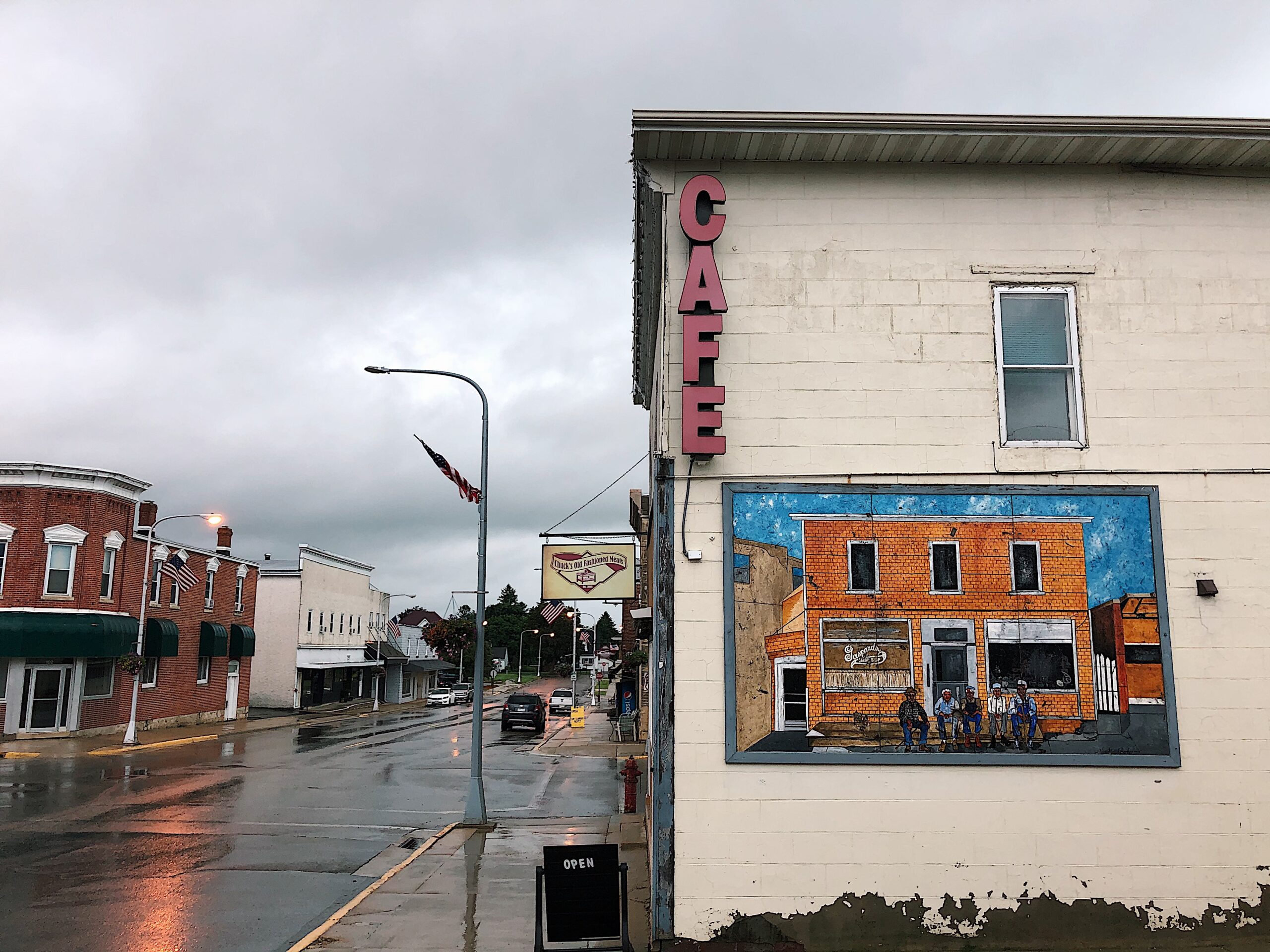This piece about supporting local foods is part of a larger project to document the culinary resilience of southeastern Minnesota’s Houston County during the pandemic. You can read more about my Crystal Creek Citizen-Artist Residency project here.
On an afternoon in early September, I arrive at Nettle Valley Farm in rural Spring Grove to meet Dayna Burtness and Nick Nguyen. Dayna and I immediately start talking about topography. Houston County is part of the Driftless Region—a specific section of the Midwest that escaped the geological impact of glaciers. The region covers parts of southeast Minnesota, southwest Wisconsin, northeast Iowa, and northwest Illinois.
The hills and bluffs of the Driftless Region lead to more small and medium-sized farms. It’s a sharp contrast to the prairies of western Minnesota where I grew up, where larger farms dominate the landscape with infinite rows of corn and soybeans. There we find “horizontal grandeur,” a phrase coined by the late Bill Holm, a poet from southwestern Minnesota.
Nettle Valley Farm raises pastured pork. In an attempt to balance what Dayna calls “the weird nexus of soil health, farmer happiness, and pig happiness,” they use a wagon wheel model. A central hub provides water, shelter, and organic pea & barley rations for the pigs. It rained yesterday, so Dayna is waiting to let the pigs graze. “Pigs on pasture after the rain is basically like having 73 rototillers going at once,” she explains. Pigs have an excellent sense of smell—they’re likely salivating over the waiting heap of melons and apples.

Nettle Valley Farm receives culled organic fruits and vegetables from Featherstone Farm in Rushford each week. The flavor and fat components of a pig’s diet directly impact the flavor of the pork. “The terroir of our pork really changes from year to year if it’s a good walnut or acorn year or if it’s mostly melons,” Dayna describes. “It’s one of the reasons I love pigs. It’s so fun to craft a diet for them,” she adds.
The pigs arrive at Nettle Valley Farm weighing about 80 pounds. After grazing on melons, apples, and other tasty morsels from July until late October and putting on over 200 pounds in the process, they’re sent to be butchered starting in late October. A 300-pound pig produces 150-170 pounds of meat. Interested customers reserve a whole or half pig, pay a deposit, then pick up their pork from the butcher.
This year, Nettle Valley Farm is raising black and white purebred Hampshires. As we walk their way, the pigs immediately run to Dayna as if they know her. “Well, they should!” she exclaims. “There’s Balloon Ear. And Little Spot. And Big Spot!” she tells me, pointing out a few of the piggos, as she calls them.

“Come on, I’ll show you the chickens,” Dayna says. She uses their eggs as training treats to reward the pigs. “Pigs love eggs,” Dayna says with wide eyes.
Dayna hopes to change the perception that farm eggs are expensive. “People always tell me that you can get 99 cent eggs at the gas station,” Dayna chuckles. She describes her past experience selling eggs at the farmers market. “I wanted to make a giant sign that said, ‘SIX BREAKFASTS: $4!’ And people would think ‘Wow, a whole breakfast!’ And they’d come over and it would be a dozen eggs,” Dayna laughs. “Eggs cost less than the price of your latte!” she adds.
Nettle Valley Farm started in 2015. Dayna and Nick moved to Spring Grove in hopes of buying a farm and fell in love with the area. “There are interesting people doing interesting things, especially women. And it’s beautiful. We decided to stay,” Dayna tells me.
After living in a travel trailer in the woods with no running water, their current farmstead came up for sale: a beautiful, old house with a wraparound porch, an existing barn, sheds, and a wagon wheel hub. The site provided a way for them to start an incubator farm, a concept Dayna learned about while vegetable farming in Northfield. Working on an incubator farm was crucial for her business development, and she wanted to pay that forward.
Two farmers, Heidi Eger and Bailey Lutz, are in their second year living at Nettle Valley’s incubator farm. It’s not an apprenticeship—they each run their own farms. Bailey of Listenmore Farm raises heritage breed ducks and forest-raised Kiko goats. Heidi of Radicle Heart Farm raises grass-fed Katahdin-Dorper sheep and chickens. The two work jobs off the farm in addition to caring for their flocks and herds.
I am amazed by this collaborative group of farmers. In addition to caring for their own animals, they help each other. The mental and physical strain of farming can be overwhelming. Farmers need community, and the incubator farm provides a good model for combating isolation.
As we walk around the farm, Dayna asks what I’ve discovered while documenting Houston County’s COVID-19 food stories. When I mention that people are buying more locally, she immediately says, “I hope it sticks.” Later that evening when I mention this shift to local foods, Nick responds similarly. “But do you think it will last?” he asks me.
That is the big question. Whether driven by food security or no longer commuting to a town with big box stores, people have been purchasing more from local food producers and smaller stores. This shift to local foods is mentioned by nearly every person I meet in Houston County.
For example, Karen Bennett of Houston shares that her household’s food habits have changed during the pandemic. She now purchases most of her food from Root River Market in Houston. Previously, she shopped in La Crosse. “I have been amazed at what I have been able to find right in Houston and have not noticed that we are spending significantly more money on food by doing so,” she adds.
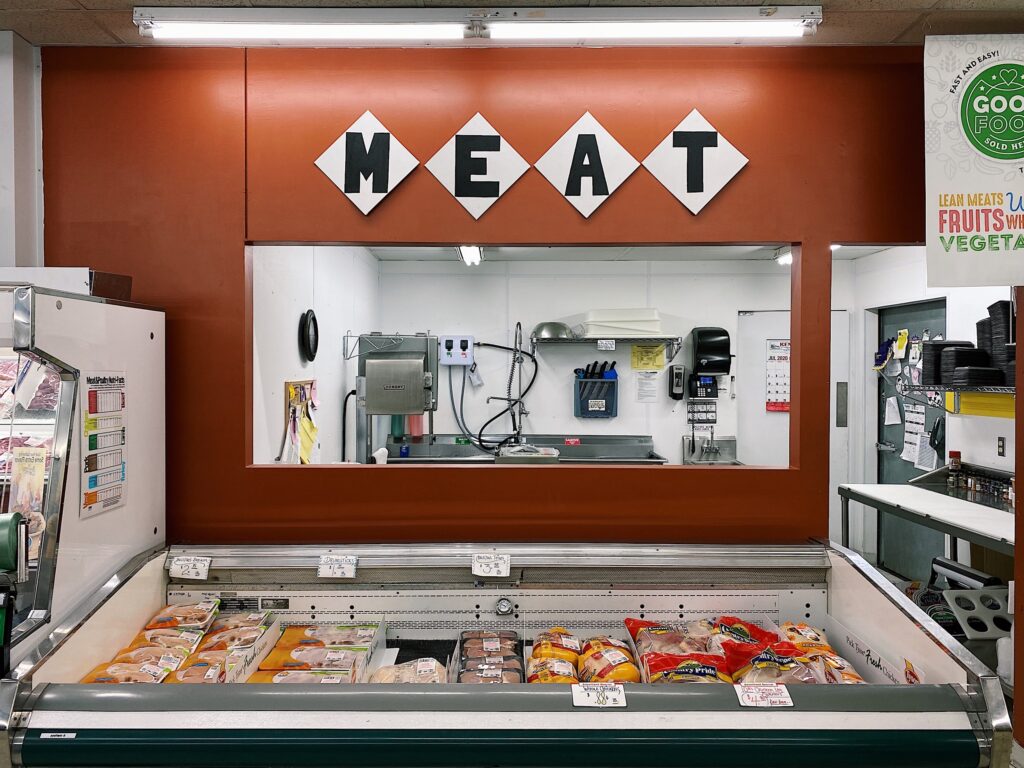
Root River Market, Houston
Allison Wagner, Director of the Houston County EDA, reports that residents are shopping closer to home. Those who used to commute to Rochester or La Crosse are working from home and buying locally. Local producers now have people seeking them out. “I hope that will carry through even beyond COVID-19, because once you find a great product and it’s close, why wouldn’t you keep pursuing it?” Allison asks.
While talking with Rachel Storlie at the Spring Grove farmers market, our conversation turns to buying locally. Rachel just picked up five whole chickens from a tiny farm outside Spring Grove. “I didn’t even know they existed until I found a post on Facebook about organic eggs,” Rachel says. When she went to pick up the eggs, she saw chickens for sale and ordered some. “I have to say, in a pre-COVID idealized romantic reality, I may have done something like that, but the chances are…probably not. I probably wouldn’t drive to a little farm and pick up chickens,” Rachel says.
Rachel ordered a pastured pig from Nettle Valley Farm last year and is enjoying cooking through it. She also mentions cheese deliveries from a former Spring Grove resident during the pandemic. “Cheese just coming right to your home—how can you say no to that?” Rachel laughs.
I also chat with Chelsea McManimon-Moe. Chelsea mentions that before COVID-19 she wouldn’t have known where to go for certain local foods, but now it seems possible to find items like mozzarella cheese or mushrooms locally. “Maybe we’re all just becoming more connected. It’s cheesy, but it does feel like we’re learning how to rely on each other a lot more,” Chelsea says.
While visiting Wholesome Family Farms, owners Jordan and Rachelle Meyer agree that the local focus has been really good for small farmers. They’ve already sold out of beef for the year, and they sold out of eggs in the initial pandemic rush. Demand was so high that they added another 50 chickens and now have 350 layers. Rachelle delivers eggs to Caledonia and Spring Grove regularly and meets customers for pickups to make it easy.
Wholesome Family Farms also sells eggs to Free Range Exchange in Hokah, MN. “They buy our eggs, we buy their food. The kids have a muffin. We try to buy as locally as we can, whether that’s appliances for our house or whatever else. People don’t realize that when you buy locally, you’re not supporting this huge corporation, you’re supporting a family,” Rachelle says.
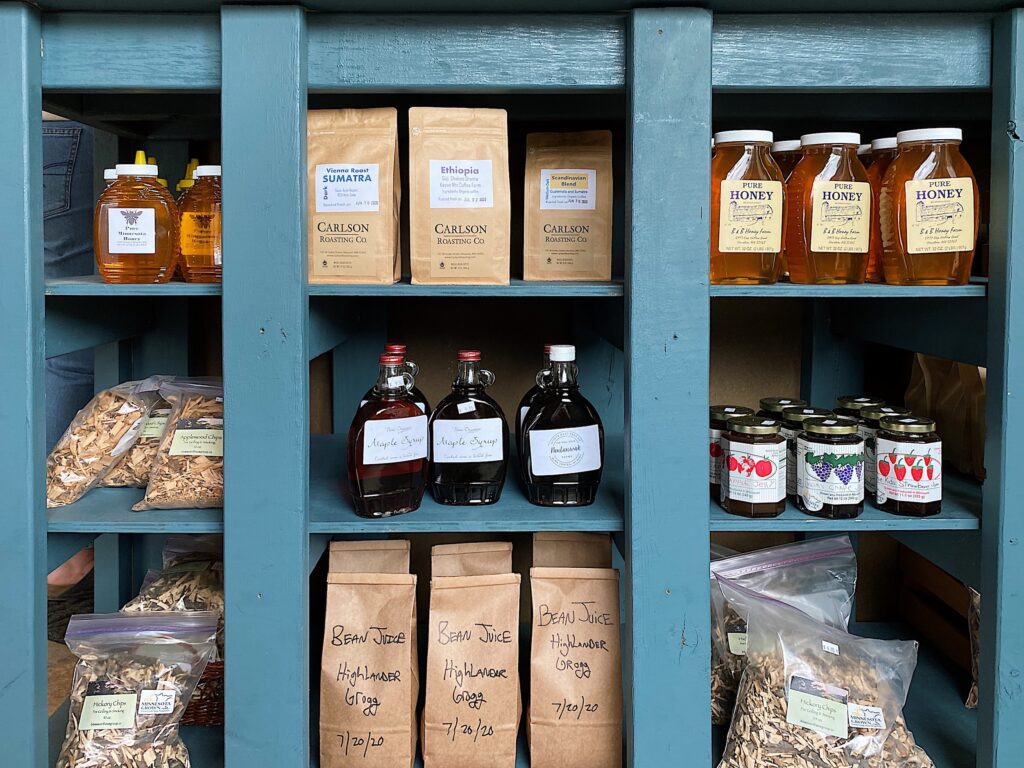
Free Range Exchange, Hokah
Free Range Exchange, a farmers market–café mashup, offers local provisions like eggs and vegetables in a cooler case next to the coffee counter. You can purchase a stellar chocolate muffin, a locally-roasted cup of coffee from Houston’s Carlson Roasting Company or Caledonia’s Heart Rock Coffee, a bagel sandwich, and your eggs for the week all in one stop. A chalkboard on the wall highlights their suppliers. Ben Horn, one of the owners, mentions that customers have started buying directly from the farmers listed on the board making it tricky for Free Range Exchange to secure certain local foods. “But it’s a good problem!” he laughs.
Back at Nettle Valley Farm, we sit on the wraparound porch enjoying a spread of local foods—fried green tomatoes, cucumber and tomato salad, freshly baked buns, melon, homemade barbeque sauce, and of course, Nettle Valley Farm’s pastured pork smoked short ribs.
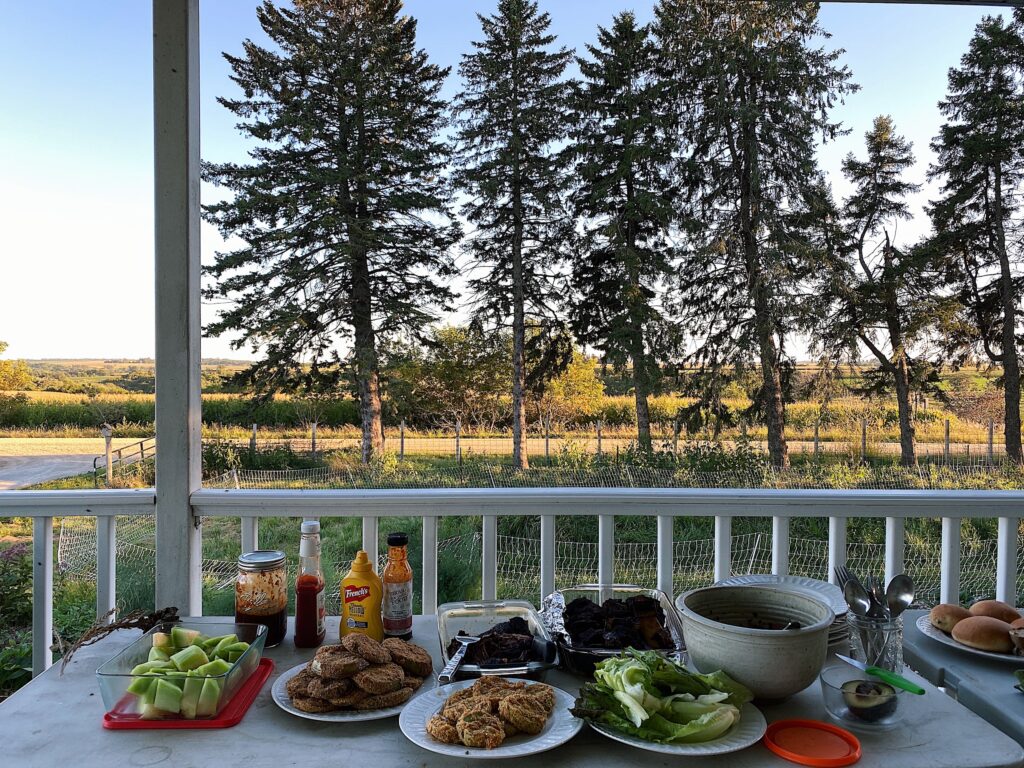
Later that evening, we watch the golden moon rise over newly-installed solar panels. As the moon crests the horizon, it’s so large it almost looks fake. With the chirp of insects, the soft quacking of ducks in the background, and the gorgeous moonrise, I will remember this evening for a long time.
I drive home with the moon out my window and the stars bright overhead thinking about local foods. Will this pandemic-induced shift towards local foods continue? How can we maintain the mindset of local foods first—shopping first at our local producers and farmers markets, then at our local grocery stores and coffee shops?
When food systems and supply chains were threatened in the early days of the pandemic, our local food producers were here for us. They continue to go the extra mile to make local food accessible by adding chickens to meet demand and driving all over the county to deliver food. But they won’t always be here unless we keep supporting them.
As Allison says, “Once you find a great product and it’s close, why wouldn’t you keep pursuing it?”
For more information about local foods, check out Local Food is Essential or the Driftless Grown Member Directory.

Elisabeth A. Fondell is a writer, potter, and food enthusiast living in the rural Midwest. She is currently working on Food Stories From Houston County, a project documenting stories of culinary resilience in Minnesota’s southeastern-most county through the Crystal Creek Citizen-Artist Residency.
Elisabeth began focusing on place-based food writing after receiving a grant from the Southwest Minnesota Arts Council to create a body of work celebrating the intersection of food and culture. See that exhibit here.







